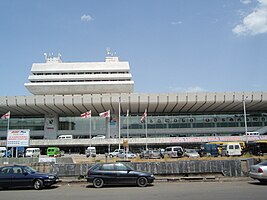Tbilisi Central Uri Sadguri
| Tbilisi Centraluri Sadguri (Tbilisi Central Railway Station ) |
|
|---|---|
|
Tbilisi Central Uri Sadguri
|
|
| Data | |
| Platform tracks | 5 |
| opening | 1872 (first building) 194x (second building) 1982 (today's building) |
| Conveyance | 2015 (planned) |
| Website URL | www.tbilisicentral.ge |
| Architectural data | |
| Architectural style | brutalism |
| architect | R. Bairamashvili, I. Qawlashvili, G. Shawdia, A. Djibladze |
| location | |
| City / municipality | Tbilisi |
| Capital | Tbilisi |
| Country | Georgia |
| Coordinates | 41 ° 43 '15 " N , 44 ° 48' 0" E |
| Railway lines | |
|
Poti – Baku |
|
Tbilissis Zentraluri Sadguri ( Georgian თბილისის ცენტრალური სადგური , Tbilisi Central Station ) is the central passenger station of the Georgian capital Tbilisi and also the country's most important passenger rail hub .
history
The first central station of the city of Tbilisi was opened in 1872 after the opening of the first section of the Poti – Baku railway line at the location of today's station.
In the 1940s the reception building was replaced by one in Stalinist architecture . This in turn no longer met traffic requirements from the 1970s and was replaced by a building opened in 1982 in brutalist architecture . The architects of the building R. Bairamashvili, I. Qawlashvili, G. Shawdia and A. Djibladze won a state award for their work in 1992.
service
Long-distance transport
International connections operate from here
- a daily pair of trains to Baku and
- A pair of trains runs to Yerevan several times a week . The latter runs daily in summer and continues to and from Machindschauri on the Black Sea .
In domestic traffic, there are connections to all major cities in the country, both by night and day trains, to Kutaisi , Zugdidi , Batumi , Osurgeti and Poti .
Regional traffic
In transport are Gardabani , Sadachlo and the Tbilisi airport approached.
Local traffic in the west was carried out until March 2011 from a separate part of the station, the Borjomi station ( Georgian თბილისის ბორჯომის ვაგზალი ). The Borjomi station had its own reception building 200 m west of the reception building of the central building. It was shut down for passenger traffic in 2011. The regional trains in the direction of Borjomi have been departing from platform 2 of the main station since then.
Subway
At the central station is the Sadguris Moedani ' transfer station (formerly: Wagslis Moedani ) ( Georgian Bahnhof მოედანი , "station square ") between the two lines of the Tbilisi Metro .
Present and Future
The station is part of the railway infrastructure of the Sakartwelos Rkinigsa , the Georgian Railway . The station building was gradually renovated from 2006 onwards. Large parts of it were converted into a shopping center (Tbilissi Zentrali) and reopened in May 2010.
The railway line through Tbilisi is to be replaced in the coming years by a double-track, 27 km long bypass line north of Tbilisi. Passenger traffic in the city is to have two head stations - Didube station in the north-west of the city (at the Tbilisi metro station of the same name ) - and Nawtlughi station in the south-east (near the Samgori metro station). Today's central station is to be shut down and the railway infrastructure dismantled after the new line has opened. A continuous connection for passenger trains and direct transfers for travelers traveling beyond Tbilisi will then no longer be possible. Timetables for this project have not yet been published. Unlike the US consultancy Booz Allen Hamilton , Western European transport experts rate the project rather negatively because of these effects.
literature
- Markus Rabanser: Georgia . In: Fern-Express 1/2016, pp. 20–26.
Web links
- Web presence of the central station / shopping mall Tbilisi (English, Georgian; Flash player required)



